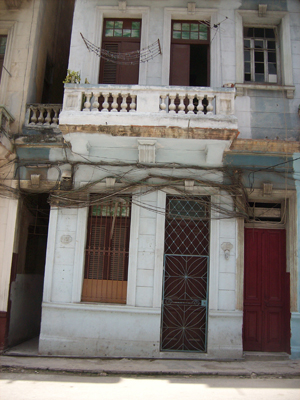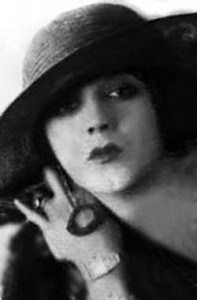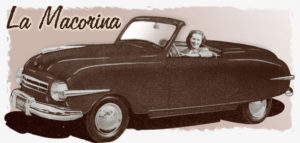“The MACORINA”: MEMORIES OF AN UNFORGETTABLE WOMAN.
Whether the poem written by the Spaniard Alfonso Camín in the year 1931, or the chorus that the singer Abelardo Barroso became a success, the truth is that, half a century of having died, still in Havana the memory of Macorina, who according to her neighbor, Mercedes Chacón Aballí, “was very sympathetic and tiposa as a child” “, good neighbour and very helpful”.
https://youtu.be/DLkczFuwp-s?list=RDDLkczFuwp-s
Maria Calvo Nodarse, Macorina, was born in 1892 in the village of Guanajay, then belonging to the province of Pinar del Rio.
Of she, says its neighboring Mercedes: “helped much to the people of the block, never said that was rich, but more or less one it captured, was a woman gladly and drove a Pontiac and a Cadillac”.
His love of cars, in addition to being a woman full of attractions, Macorina, who arrived in Havana identified “with a man who promised to love me forever, that it was my first and only love, and that I will remember until my death”, event that took place on June 15, 1977.
Rogelio RAM Perez of teenager jumped from roof rooftop to observe the movements of the spectacular woman in your home of Prince 155, between San Francisco and sword, in Centro Habana, one of the many houses of appointment of the Muse of the Cuban artist Cundo Bermúdez.
RAM Perez recalls: “Macorina arrived at this home in the year 1943, adding that property to others that he had, and when she looked out are people very older asked a weight, that she gave them gladly.
“It was very nice, the owners of agencies gave him cars. Each year she parked them here a ‘new package’ car. “The banker and representative to the camera, Amadeo Barletta, you gave a truck convertible of the year 55, brand new, of the same type that you gave to the Queen of the Carnival”.
When asked about the sad end, dark and solitary of Macorina, that concern some authors, among them Miguel Ojeda Vila, RAM Perez responded: “I didn’t see that he died poor, or anything of that, because she had quite a few houses and a son who had machines that she provided him when they presented him with a new. That was the most common.
“Yes, I will remember that when they mourned her at the funeral home in Belascoain and ditch, I was there and that was well attended and had many crowns of flowers.”
Honors, perhaps those who provided their favors, or of those who knew her beauty, or knew it as the first Cuban who drove a car on the island and obtained the first license of driving provided by the municipality of Havana; skill Macorina marking, according to the testimony of Rogelio Carnero: “out the Prince Street until the road of Infanta, instead of stopping on the left, hit the curb and people ran to see it out of the window”.
Your accent, soft and sweet, / Mockingbird that in the morning / all your song reels. / Made indigenous song, / your cold sore eyes; / your blood, notes of an are; / your mouth, a blessing / mature soursop; /TUS breasts, anon, / and thin waist / the same as the danzón! / Mist of cane and peanuts: “put, put your hand here, Macorina”.
Fragments of the poem Macorina, which the Mexican Chavela Vargas musicalizara and which were amplified in the chorus that popularized Barroso with the Orchestra feel, in the second half of the fifties of the twentieth century.
Put me it hand here Macorina / that I die Macorina / put me the hand here Macorina / that me hurts Macorina / put me the hand here Macorina / that am crazy Macorina / put me it hand here Macorina / put me the hand here.
Only a being of Chavela Vargas described it: “an exceptional woman… a mulatto daughter of black and Chinese;” an exemplary female that only it I have seen in Cuba: Macorina had a color of skin exact to the sheet of the tobacco. His eyes were green and had straight hair that arrived at the waist. “All which it met not it have could forget never”, could be the diva of not few deadly, as the then beardless Rogelio RAM Perez who, completed them 87 years, it recalls screaming you: “Rogelio is it go to tell to your breast”, when the young was of see it, helping is of a mirror, from the roof of it House of it Street Prince , number 155.
39 years of the death of Macorina, one of the characters that also make the history of this wonderful city, Mercedes Chacón, who met her when he lived the palatial house of San Miguel 561 Belascoain and Gervasio wishes: “plenty of light to Macorina… because it was complete”.
Agencies/R.Coco/Cáliz Moré Leal/InternetPhotos/Arnold Varona/TheCubanHistory.com
THE CUBAN HISTORY, HOLLYWOOD.
“LA MACORINA”: RECUERDOS DE UNA MUJER INOLVIDABLE.
Ya sea por el poema escrito por el asturiano Alfonso Camín en el año 1931, o el estribillo que convirtió en un éxito el cantante Abelardo Barroso, lo cierto es que, a medio siglo de haber fallecido, aún queda en La Habana el recuerdo de Macorina, quien al decir de su vecina, Mercedes Chacón Aballí, “era muy simpática y tiposa desde niña, buena vecina y muy servicial”.
https://youtu.be/DLkczFuwp-s?list=RDDLkczFuwp-s
María Calvo Nodarse, Macorina, nació en el año 1892 en el poblado de Guanajay, entonces perteneciente a la provincia de Pinar del Río.
De ella, asevera su vecina Mercedes: “Ayudaba mucho a la gente de la cuadra, nunca dijo que era rica, pero más o menos uno lo captada, era una mujer alegre y manejaba un Pontiac y un Cadillac”.
Su gusto por los automóviles, además de ser una mujer llena de atractivos, identificaba a Macorina, quien llegó a La Habana “con un hombre que prometió amarme por siempre, que fue mi primer y único amor, y que recordaré hasta mi muerte”, suceso acaecido el 15 de junio de 1977.
Rogelio Carnero Pérez de adolescente saltaba de azotea en azotea para observar los movimientos de la espectacular mujer en su vivienda de Príncipe 155, entre San Francisco y Espada, en Centro Habana, una de las tantas casas de cita de la musa del pintor cubano Cundo Bermúdez.
Carnero Pérez rememora: “Macorina llegó a ese domicilio en el año 1943, sumando esa propiedad a otras que ya tenía, y cuando ella se asomaba las personas muy mayores le pedían un peso, que ella les entregaba gustosamente.
“Era muy bonita, los dueños de agencias le regalaban los automóviles. Cada año ella parqueaba aquí un carro ‘nuevo de paquete’. El banquero y representante a la cámara, Amadeo Barletta, le regaló un carro convertible del año 55, nuevecito, del mismo tipo que le regalaba a la Reina del Carnaval”.
Al preguntarle sobre el final triste, oscuro y solitario de Macorina, que refieren algunos autores, entre ellos Miguel Ojeda Vila, Carnero Pérez respondió: “Yo no vi que muriera pobre, ni nada de eso, porque ella tenía bastantes casas y un hijo que tenía maquinas que ella le proveía cuando le obsequiaban una nueva. Eso era lo más corriente.
“Sí recuerdo que cuando la velaron en la funeraria de Belascoain y Zanja, yo estuve ahí y aquello estaba bien concurrido y había muchas coronas de flores”.
Honores, tal vez de aquellos a los que brindó sus favores, o de quienes conocían su hermosura, o la conocían como la primera cubana que manejó un automóvil en la isla y obtuvo la primera licencia de conducción entregada por el municipio de La Habana; habilidad que Macorina marcaba, de acuerdo al testimonio de Rogelio Carnero: “Al salir por la calle Príncipe hasta la calzada de Infanta, en vez de parar por la izquierda, se pegaba a la acera y las personas corrían para verla por la ventanilla”.
Tu acento, suave y dulzón, / sinsonte que en la mañana / todo su canto desgrana. / Cocuyos hechos canción, / tus ojos de calentura; / tu sangre, notas de un son; / tu boca, una bendición / de guanábana madura; /tus senos, carne de anón, / ¡y era tu fina cintura / la misma de aquel danzón! / Vaho de caña y maní: “Pon, ponme la mano aquí, Macorina”.
Fragmentos del poema Macorina que musicalizara la mexicana Chavela Vargas y que fueron amplificados en el estribillo que popularizada Barroso con la Orquesta Sensación, en la segunda mitad de los años 50 del siglo XX.
Ponme la mano aquí Macorina / que me muero Macorina / Ponme la mano aquí Macorina / que me duele Macorina / Ponme la mano aquí Macorina / que estoy loco Macorina / Ponme la mano aquí Macorina / ponme la mano aquí.
Solo un ser como la describió Chavela Vargas: “Una mujer excepcional… una mulata hija de negra y chino; un ejemplar femenino que solamente lo he visto en Cuba: Macorina tenía un color de piel exacto a la hoja del tabaco. Sus ojos eran verdes y tenía cabellos lacios que le llegaban a la cintura. Todos los que la conocimos no la hemos podido olvidar jamás”, pudo ser la diva de no pocos mortales, como el entonces imberbe Rogelio Carnero Pérez quien, cumplidos los 87 años, la recuerda gritándole: “Rogelio se lo voy a decir a tu mamá”, cuando el joven trataba de verla, ayudándose de un espejito, desde la azotea de la casa de la calle Príncipe, número 155.
A 39 años del fallecimiento de Macorina, uno de los personajes que también hacen la historia de esta Ciudad Maravilla, Mercedes Chacón, quien la conoció cuando habitaba la casa palaciega de San Miguel 561 entre Belascoaín y Gervasio le desea: “Mucha luz para Macorina… porque era completa”.
Agencies/R.Coco/Cáliz Moré Leal/InternetPhotos/Arnoldo Varona/TheCubanHistory.com
THE CUBAN HISTORY, HOLLYWOOD.







